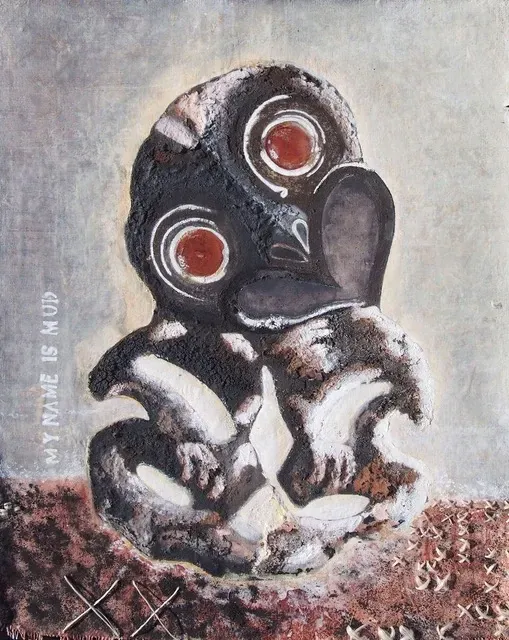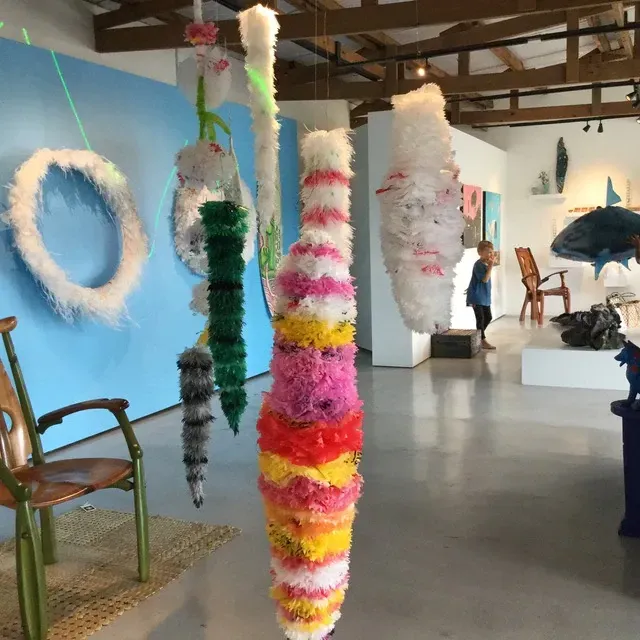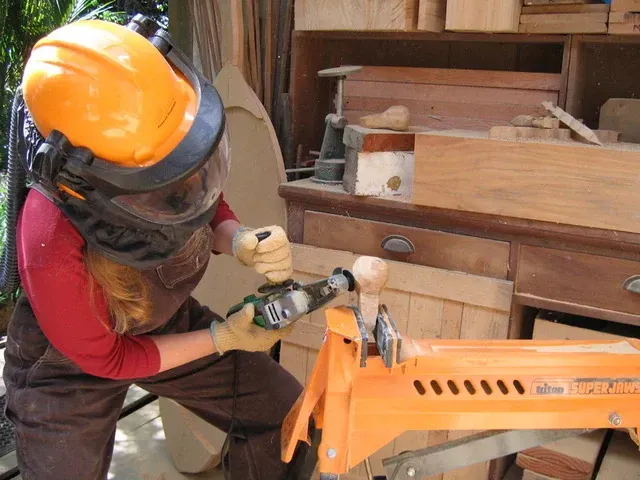On The Edges: Hokianga (part one)
Written by

There is a Māori whakatauki that you’ll hear often: Ka mua, ka muri. We walk backwards into the future. We need to look back to move forward. It’s a great life navigational aid.
The Hokianga is a place that feels deeply, visibly engaged with its past. From Māori and colonial heritage, to a rich natural environment. With that comes self-awareness that you can’t move forward without addressing your past.
The Hokianga is where Anthony Byrt’s 2016 book of essays on New Zealand artists’ This Model World ends. In this final placement there’s the whiff of this harbour as a place of new beginnings. Edges forever feeding centres.
On my own occasional visits, the ground has felt fertile, warm. When all has turned mad a good place to start again, feet firmly planted. The harbour’s abundant communities of mangroves come to mind. Trees rooted in lapping salty brine and a soft, rich tidal accumulation of mud.
The role of the artist as conduit for all this complexity feels natural here. And there are many artists here. Putting my feelers out by email and web, I’m impressed by the range of initiatives artists have established to sustain themselves and each other. They are playing a leading role in community building: newcomers from all corners of the world, and those born and bred.
Yet don’t forget the ground. As one of my correspondents reminds me: “Our community is one of the most socially and economically challenged areas in New Zealand and 73% of the population is Māori.” Great opportunities and challenges alike greet you.

Heiwari Johnson
“Ko Ngatokimatawhaorua Te Waka
Ko Nukutawhiti Te Tangata
Ko Te Ahuahu Te Maunga
Ko Omapere Te Roto
Ko Te Uri Taniwha Te Hapu
Ko Ngapuhi Te Iwi
Ko Hokianga Te Moana
“My name is Heiwari Johnson. I am an artist and independent curator who has lived and worked in Kohukohu, Hokianga for the past 30 years. During this time I have continued to paint, weave and curate several exhibitions in the Hokianga, Northland and Auckland regions.
“For the past seven years I have worked as artistic director for black_space gallery whose primary kaupapa is to provide a forum to showcase Hokianga Māori artists and their art. Te W'akaputanga Mai O Te Rangatiratanga an exhibition shown at the Depot Artspace, Auckland in 2013 featured artworks and artist statements from twelve artists including installation artist Maureen Lander, weaver and painter Toi Te Rito Maihi, painter Bev Wilson, photographers Claire Kahu-White and Heather Randerson.
“Hokianga the river, and the landscape are steeped in rich traditional narratives which continue to inspire and influence the artists who create art 'of this space'. This is often referred to as 'Hokianga, my place' and are connected to the land and each other through a shared whakapapa. It is from this reference point that artists are able to render stories/histories in a contemporary context.
“Hokianga artists contribute to exhibitions hosted on a regular basis by three community run art venues; Village Arts Gallery in Kohukohu, No 1 Parnell Gallery, Rawene and most recently Te Pu O Te Wheke in Kaikohe. Artists are also invited to show works outside the area at Uku Toi, Paihia and Kings Theatre Gallery in Kawakawa. Many artists also participate in the Tai Tokerau Contemporary Māori artist's showcase as part of the Ngapuhi Arts Festival.
“Hokianga continues to attract an array of artists... artists who are returning to papakainga from previous urban environments, whereby contributing to and strengthening existing networks in a flourishing art community.”

Lise Strathdee – Outpost Hokianga
Byrt introduced me to designer Lise Strathdee through his book’s final chapter. Like many other Pakeha emigres here, Strathdee stumbled on the Hokianga on a tiki tour. She had spent many years working overseas, first in Milan and then London, and decided to stay.
Moving here in 2004 she commuted between Kohukohu on the harbour’s northern banks and Europe for three years. She started running Outpost Hokianga as a ‘seasonal concept store’ from the summer of that first year.
“I have found it to be a very welcoming and tolerant place,” writes Lise to me. “After years of living and working in big cities I wanted to experience living in an environment rich in plant and bird life. I realized that my optimal conditions of existence needed to include the sun, sky, water, verdant nature, beauty, magic and art on a daily basis.
“Also important to me is living in and finding out about Māori culture and customs. I’ve always lived within a different culture than my own. And I love village life for the most part. There’s a lot of spontaneity.
“Living remotely has its challenges and its rewards. My work and life have fused in enriching and unimaginable ways. It hasn’t been an obvious or even a smart career choice but it is a choice that is in sync with my core values and the way I want to be in the world. And... it is a political choice, I now realise, to be based here.”
“The internet has revolutionised most of the traditional divides between town and country. The concept of centre, of its importance in artistic life is being overridden by the access to information and therefore the ability to be ‘contemporary’. It’s now more about different environments that we interact with and the creative results of that interaction.”
Strathdee values the crossover of art and craft - of the artistic and the artisanal - in the Hokianga.
“It is similar to how it is in fashion. People are approaching their art making from such different angles and there is freedom here to do this. No-one comes here to become ‘rich and famous’ and I find that incredibly liberating. It was such a relief to exit the ‘me –me- me’ competitive, ego mind-set that you need for survival and success in the big cities. Here it feels like it’s more about contributing to the culture of your community. That’s how I feel about the art life here, everyone contributes to a bigger picture.”
“When I opened Outpost Hokianga my mantra was ‘inclusivity is the new exclusivity’. The concept of exclusivity is a capitalist mechanism to manipulate peoples’ desires and sense of self to drive sales. That feels so 20th century. We’re in 2017. Let’s figure out other ways to move and groove.”
At the time Outpost Hokianga opened there were only two art outlets in Hokianga, one crafts oriented at the Boatshed Café in Rawene and the other, Mamaku Gallery on the shore at Omapere run as an artist co-op (since closed). Now there are at least three more.
Yet Strathdee also feels that some momentum from the time they arrived has been lost locally. Like others I talk to she rues the loss of the arts course at Northland Polytechnic’s Rawene Campus which ran for five years. Led by Sue Daly it gave many people an opportunity to upskill and develop their art practice. That legacy is alive in the Hokianga.
“It was disheartening… the dismantling and selling off all the specialised art equipment. To see the arts be so soundly invested in, at a practical, foundational community level only to be dissolved a few years later didn’t make sense to me. When you plant a seed it takes some years for the tree to grow... A summer school for the arts, using the campus in the academic down time could have worked. A thriving art scene isn’t just about selling work to visitors and collectors, but also about creating opportunities for connections between people and cultures.
“Fortunately the campus is still operating and last winter a fantastic weaving course was run by Reva Mendes for Te Wananga Aotearoa. I hope that more opportunities like these will return to Hokianga. Reva is moving forward along with others in the community to create an area that will contain many different varieties of harakeke suitable for weaving.”
Strathdee was associate editor of Stingray, a now defunct free quarterly Northland arts and culture ‘rag-azine’ and laments how changes in the media have not helped the Hokianga.
“Stingray was an ingenious low budget way to connect the dots in the arts in a geographically big and disparate region. The tourism industry needs to become more sophisticated. To express the artistic culture of a region through print media in an intelligent way which isn’t focused purely on the direct sale advert builds up an identity for everyone involved.
“When we arrived in 2002 until 2011 there was a real sense of growth and of building an arts identity, and then most of that dissolved into the ether. The global financial crash and change of government dealt a huge blow to the arts, to tourism, to the sense of initiative and to the buzz. But, recessions also provide opportunities and in the last few years’ new operators have arrived, buildings have been restored, and there are new art ventures.”
Strathdee is in the process of making a book about the first 12 summers of Outpost Hokianga. “As I look forward, then back, I am thinking about what I will do next.

Liz McAuliffe
In Liz McAuliffe’s sculptures the minutiae of Nature are magnified. Seed pods, leaves and shells. “I have made it a conscious choice to create art with, of and for Nature.” From her bush-clad five acre Kohukohu base, her work then goes out into the world, exhibited and collected widely. McAuliffe is one who trained under the tutelage of Sue Daly, as well as Glen Hayward and Andrea Daly, and more recently Harriet Stockman and Maree Wilson. She names these tutors as her continued inspiration.
Building a practice since 2007, in 2016 McAuliffe participated in a three-month Artist in Residence programme at Bogensholm, Mols Berg National Park in Denmark. It culminated there in a solo exhibition and sales and commissions followed. “The residency gave me an amazing amount of confidence and provided information on international art practices.”
McAuliffe moved to the Hokianga 12 years ago. “I lived on the South side about 30 years ago and had two babies in the Rawene Hospital. I have a feeling and desire that this is where I wish to live forever.”
What makes her particular place special? An uninterrupted view over the harbour, (“daily it is a visual feast for me”), living alone in an owner built hexagonal home, great art colleagues and a supportive friendly community. “Living here allows me to live a simple, quiet and disciplined life.”
The three main local galleries are nearby: Village Arts and Art of This World in Kohukohu and No.1 Parnell in Rawene. “Both No.1 and Art of This World exhibit artists from outside, which gives locals a feel of ‘what’s out there’… All these galleries provide amazing venues for continued networking between artists, the community and buyers.”
She speaks highly of local artists Dawn Harris and Heiwari Johnston for their work bringing artists together, organising group shows both locally and in other regions.
“Being a small close community can help in sustainability: networking with the diverse range of people in the district, giving and getting support in a variety of ways, and creating critiquing groups.”
Challenges?
“We are colourful folk, misfits, drop outs, and introverts, seeking something ‘different’. This does seem to mean that some local artists lack confidence in themselves and their art practices. They can have a tendency to not push themselves, to give up easily or early in learning skills, particularly business and marketing ones. My advice for that is to pick one thing that would expand themselves and set a timeline to do it, break it down to manageable portions... and then do it.”
This marks the end of Part One of Mark Amery’s eye on Hokianga. Look out for next week’s ‘On the edges: Hokianga (part two)’.

